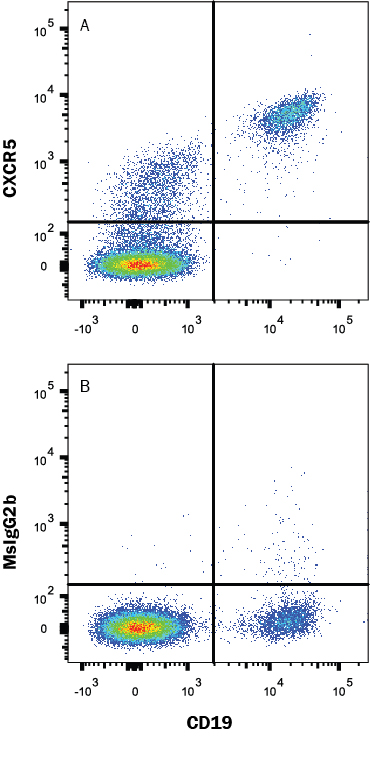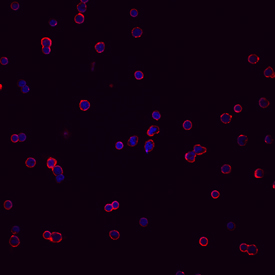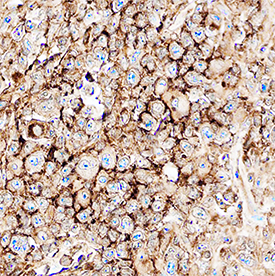Human CXCR5 Antibody
Human CXCR5 Antibody Summary
Applications
Please Note: Optimal dilutions should be determined by each laboratory for each application. General Protocols are available in the Technical Information section on our website.
Scientific Data
 View Larger
View Larger
Detection of CXCR5 in CD19+ Human PBMCs by Flow Cytometry. Human peripheral blood mononuclear cells (PBMCs) were stained with Mouse Anti-Human CD19 APC-conjugated Monoclonal Antibody (Catalog # FAB4867A) and either (A) Mouse Anti-Human CXCR5 Monoclonal Antibody (Catalog # MAB190) or (B) Mouse IgG2B control antibody (Catalog # MAB0041) followed by anti-Mouse IgG PE-conjugated secondary antibody (Catalog # F0102B). View our protocol for Staining Membrane-associated Proteins.
 View Larger
View Larger
CXCR5 in Human PBMCs. CXCR5 was detected in immersion fixed human peripheral blood mononuclear cells (PBMCs) using Mouse Anti-Human CXCR5 Monoclonal Antibody (Catalog # MAB190) at 10 µg/mL for 3 hours at room temperature. Cells were stained using the NorthernLights™ 637-conjugated Anti-Mouse IgG Secondary Antibody (red; Catalog # NL008) and counterstained with DAPI (blue). View our protocol for Fluorescent ICC Staining of Non-adherent Cells.
 View Larger
View Larger
CXCR5 in Human Kidney. CXCR5 was detected in immersion fixed paraffin-embedded sections of human kidney using Mouse Anti-Human CXCR5 Monoclonal Antibody (Catalog # MAB190) at 5 µg/mL overnight at 4 °C. Tissue was stained using the Anti-Mouse HRP-DAB Cell & Tissue Staining Kit (brown; Catalog # CTS002) and counterstained with hematoxylin (blue). Specific staining was localized to cell membranes. View our protocol for Chromogenic IHC Staining of Paraffin-embedded Tissue Sections.
 View Larger
View Larger
Chemotaxis Induced by CXCL13/BLC/BCA‑1 and Neutralization by Human CXCR5 Antibody. Recombinant Human CXCL13/BLC/BCA-1 (Catalog # 801-CX) chemoattracts the BaF3 mouse pro-B cell line transfected with human CXCR5 in a dose-dependent manner (orange line). The amount of cells that migrated through to the lower chemotaxis chamber was measured by Resazurin (Catalog # AR002). Chemotaxis elicited by Recombinant Human CXCL13/BLC/BCA-1 (0.05 µg/mL) is neutralized (green line) by increasing concentrations of Mouse Anti-Human CXCR5 Monoclonal Antibody (Catalog # MAB190). The ND50 is typically 0.25-1.5 µg/mL.
Reconstitution Calculator
Preparation and Storage
- 12 months from date of receipt, -20 to -70 degreesC as supplied. 1 month, 2 to 8 degreesC under sterile conditions after reconstitution. 6 months, -20 to -70 degreesC under sterile conditions after reconstitution.
Background: CXCR5
CXCR5, also known as BLR-1, is a 7 transmembrane domain protein expressed on B cells. CXCR5 mediates B cell migration following binding of CXCL13.
Product Datasheets
Citations for Human CXCR5 Antibody
R&D Systems personnel manually curate a database that contains references using R&D Systems products. The data collected includes not only links to publications in PubMed, but also provides information about sample types, species, and experimental conditions.
28
Citations: Showing 1 - 10
Filter your results:
Filter by:
-
Comparison of Follicular Helper T-Cell Markers with the Expression of the Follicular Homing Marker CXCR5 in Peripheral T-Cell Lymphomas-A Reappraisal of Follicular Helper T-Cell Lymphomas
Authors: Krenács, L;Krenács, D;Borbényi, Z;Tóth, E;Nagy, A;Piukovics, K;Bagdi, E;
International journal of molecular sciences
Species: Human
Sample Types: Whole Tissue
Applications: Immunohistochemistry -
Cytotoxic CD8+ T cells may be drivers of tissue destruction in Sj�gren's syndrome
Authors: N Kaneko, H Chen, CA Perugino, T Maehara, R Munemura, S Yokomizo, J Sameshima, TJ Diefenbach, KR Premo, A Chinju, Y Miyahara, M Sakamoto, M Moriyama, JH Stone, S Nakamura, S Pillai
Scientific Reports, 2022-09-14;12(1):15427.
Species: Human
Sample Types: Whole Tissue
Applications: IHC -
Lower peripheral helper T cell levels in the synovium are associated with a better response to anti-TNF therapy in rheumatoid arthritis
Authors: A Julià, G Ávila, R Celis, R Sanmartí, J Ramírez, S Marsal, JD Cañete
Arthritis Res. Ther., 2020-08-25;22(1):196.
Species: Human
Sample Types: Whole Tissue
Applications: IHC -
Evidence for a pathogenic role of extrafollicular, IL-10-producing CCR6+B helper T cells in systemic lupus erythematosus
Authors: F Facciotti, P Larghi, R Bosotti, C Vasco, N Gagliani, C Cordiglier, S Mazzara, V Ranzani, E Rottoli, S Curti, A Penatti, B Karnani, Y Kobayashi, M Crosti, M Bombaci, JP van Hambur, G Rossetti, R Gualtierot, M Gerosa, S Gatti, S Torretta, L Pignataro, SW Tas, S Abrignani, M Pagani, F Grassi, PL Meroni, RA Flavell, J Geginat
Proc. Natl. Acad. Sci. U.S.A., 2020-03-17;117(13):7305-7316.
Species: Human
Sample Types: Whole Cells
Applications: Flow Cytometry -
Role of CXCL13 and CCL20 in the recruitment of B cells to inflammatory foci in chronic arthritis
Authors: E Armas-Gonz, MJ Domínguez-, A Díaz-Martí, M Arce-Franc, J Castro-Her, G Danelon, V Hernández-, S Bustabad-R, A Cantabrana, M Uguccioni, F Díaz-Gonzá
Arthritis Res. Ther., 2018-06-07;20(1):114.
Species: Human
Sample Types: Whole Cells
Applications: Neutralization -
Diminished CXCR5 expression in peripheral blood of patients with Sj�gren's syndrome may relate to both genotype and salivary gland homing
Authors: LA Aqrawi, M Ivanchenko, A Björk, JI Ramírez Se, J Imgenberg-, M Kvarnström, P Haselmayer, JL Jensen, G Nordmark, K Chemin, K Skarstein, M Wahren-Her
Clin. Exp. Immunol., 2018-03-24;0(0):.
Species: Human
Sample Types: Whole Tissue
Applications: IHC-P -
p53-dependent expression of CXCR5 chemokine receptor in MCF-7 breast cancer cells.
Authors: Mitkin N, Hook C, Schwartz A, Biswas S, Kochetkov D, Muratova A, Afanasyeva M, Kravchenko J, Bhattacharyya A, Kuprash D
Sci Rep, 2015-03-19;5(0):9330.
Species: Human
Sample Types: Cell Lysates
Applications: Western Blot -
Capture-stabilize approach for membrane protein SPR assays.
Authors: Chu, Ruiyin, Reczek, David, Brondyk, William
Sci Rep, 2014-12-08;4(0):7360.
Species: Human
Sample Types: Peptide
Applications: Biacore Binding Assay -
The MEC1 and MEC2 lines represent two CLL subclones in different stages of progression towards prolymphocytic leukemia.
Authors: Rasul E, Salamon D, Nagy N, Leveau B, Banati F, Szenthe K, Koroknai A, Minarovits J, Klein G, Klein E
PLoS ONE, 2014-08-27;9(8):e106008.
Species: Human
Sample Types: Whole Cells
Applications: Flow Cytometry -
CXCR7 influences the migration of B cells during maturation.
Authors: Humpert M, Pinto D, Jarrossay D, Thelen M
Eur J Immunol, 2014-02-19;44(3):694-705.
Species: Human
Sample Types: Whole Cells
Applications: Flow Cytometry -
Blood CD4+CD45RO+CXCR5+ T cells are decreased but partially functional in signal transducer and activator of transcription 3 deficiency.
Authors: Mazerolles F, Picard C, Kracker S, Fischer A, Durandy A
J Allergy Clin Immunol, 2013-02-10;131(4):1146-56, 1156.
Species: Human
Sample Types: Whole Cells
Applications: Flow Cytometry -
IL-15 positively regulates IL-21 production in celiac disease mucosa.
Authors: Sarra M, Cupi M, Monteleone I, Franze E, Ronchetti G, Di Sabatino A, Gentileschi P, Franceschilli L, Sileri P, Sica G, Del Vecchio Blanco G, Cretella M, Paoluzi O, Corazza G, Pallone F, Monteleone G
Mucosal Immunol, 2012-07-11;6(2):244-55.
Species: Human
Sample Types: Whole Tissue
Applications: IHC-Fr -
Mouse CCL8, a CCR8 agonist, promotes atopic dermatitis by recruiting IL-5+ T(H)2 cells.
Authors: Islam SA, Chang DS, Colvin RA
Nat. Immunol., 2011-01-09;12(2):167-77.
Species: Human
Sample Types: Whole Cells
Applications: Flow Cytometry -
IL8 and CXCL13 are potent chemokines for the recruitment of human neural precursor cells across brain endothelial cells.
Authors: Weiss N, Deboux C, Chaverot N, Miller F, Baron-Van Evercooren A, Couraud P, Cazaubon S
J Neuroimmunol, 2010-04-18;223(1):131-4.
Species: Human
Sample Types: Whole Cells
Applications: Flow Cytometry -
Serum CXCL13 positively correlates with prostatic disease, prostate-specific antigen and mediates prostate cancer cell invasion, integrin clustering and cell adhesion.
Authors: Singh S, Singh R, Sharma PK, Singh UP, Rai SN, Chung LW, Cooper CR, Novakovic KR, Grizzle WE, Lillard JW
Cancer Lett., 2009-04-17;283(1):29-35.
Species: Human
Sample Types: Whole Cells
Applications: Neutralization -
Chemokine CXCL13 is overexpressed in the tumour tissue and in the peripheral blood of breast cancer patients.
Authors: Panse J, Friedrichs K, Marx A, Hildebrandt Y, Luetkens T, Bartels K, Horn C, Stahl T, Cao Y, Milde-Langosch K, Niendorf A, Kroger N, Wenzel S, Leuwer R, Bokemeyer C, Hegewisch-Becker S, Atanackovic D
Br. J. Cancer, 2008-09-16;99(6):930-8.
Species: Human
Sample Types: Tissue Homogenates, Whole Tissue
Applications: IHC-P, Western Blot -
Altered expression of the receptor-ligand pair CXCR5/CXCL13 in B cells during chronic HIV-1 infection.
Authors: Cagigi A, Mowafi F, Phuong Dang LV, Tenner-Racz K, Atlas A, Grutzmeier S, Racz P, Chiodi F, Nilsson A
Blood, 2008-09-09;112(12):4401-10.
Species: Human
Sample Types: Whole Tissue
Applications: IHC-P -
Vitamin A metabolites induce gut-homing FoxP3+ regulatory T cells.
Authors: Kang SG, Lim HW, Andrisani OM, Broxmeyer HE, Kim CH
J. Immunol., 2007-09-15;179(6):3724-33.
Species: Human
Sample Types: Whole Cells
Applications: Flow Cytometry -
Overexpression of the CXCR5 chemokine receptor, and its ligand, CXCL13 in B-cell chronic lymphocytic leukemia.
Authors: Burkle A, Niedermeier M, Schmitt-Graff A, Wierda WG, Keating MJ, Burger JA
Blood, 2007-07-25;110(9):3316-25.
Species: Human
Sample Types: Whole Cells
Applications: Neutralization -
The in vitro migration capacity of human bone marrow mesenchymal stem cells: comparison of chemokine and growth factor chemotactic activities.
Authors: Ponte AL, Marais E, Gallay N, Langonne A, Delorme B, Herault O, Charbord P, Domenech J
Stem Cells, 2007-03-29;25(7):1737-45.
Species: Human
Sample Types: Whole Cells
Applications: Flow Cytometry -
Hyaluronan-based polymer scaffold modulates the expression of inflammatory and degradative factors in mesenchymal stem cells: Involvement of Cd44 and Cd54.
Authors: Lisignoli G, Cristino S, Piacentini A, Cavallo C, Caplan AI, Facchini A
J. Cell. Physiol., 2006-05-01;207(2):364-73.
Species: Human
Sample Types: Whole Cells
Applications: ICC -
Chemokine receptor expression in rat adjuvant-induced arthritis.
Authors: Haas CS, Martinez RJ, Attia N, Haines GK, Campbell PL, Koch AE
Arthritis Rheum., 2005-12-01;52(12):3718-30.
Species: Rat
Sample Types: Whole Tissue
Applications: IHC -
Regulatory T cells can migrate to follicles upon T cell activation and suppress GC-Th cells and GC-Th cell-driven B cell responses.
Authors: Lim HW, Hillsamer P, Kim CH
J. Clin. Invest., 2004-12-01;114(11):1640-9.
Species: Human
Sample Types: Whole Cells
Applications: ICC -
Plasmacytoid dendritic cell recruitment by immobilized CXCR3 ligands.
Authors: Kohrgruber N, Groger M, Meraner P, Kriehuber E, Petzelbauer P, Brandt S, Stingl G, Rot A, Maurer D
J. Immunol., 2004-12-01;173(11):6592-602.
Species: Human
Sample Types: Whole Cells
Applications: Flow Cytometry -
Developing neonatal rabbit appendix, a primary lymphoid organ, is seeded by immature blood-borne B cells: evidence for roles for CD62L/PNAd, CCR7/CCL21, alpha4beta1 and LFA-1.
Authors: Sinha RK, Mage RG
Dev. Comp. Immunol., 2004-06-01;28(7):829-41.
Species: Rabbit
Sample Types: Whole Cells
Applications: Flow Cytometry -
Possible link between unique chemokine and homing receptor expression at diagnosis and relapse location in a patient with childhood T-ALL.
Authors: Annels NE, Willemze AJ, van der Velden VH, Faaij CM, van Wering E, Sie-Go DM, Egeler RM, van Tol MJ, Révész T
Blood, 2003-12-04;103(7):2806-8.
Species: Human
Sample Types: Whole Cells
Applications: Flow Cytometry -
Expression of functional CCR and CXCR chemokine receptors in podocytes.
Authors: Huber TB, Reinhardt HC, Exner M, Burger JA, Kerjaschki D, Saleem MA, Pavenstadt H
J. Immunol., 2002-06-15;168(12):6244-52.
Species: Human
Sample Types: Whole Tissue
Applications: IHC-Fr -
Unique subpopulations of CD56+ NK and NK-T peripheral blood lymphocytes identified by chemokine receptor expression repertoire.
Authors: Campbell J, Qin S, Unutmaz D, Soler D, Murphy K, Hodge M, Wu L, Butcher E
J Immunol, 2001-06-01;166(11):6477-82.
Species: Human
Sample Types: Whole Cells
Applications: Flow Cytometry
FAQs
No product specific FAQs exist for this product, however you may
View all Antibody FAQsReviews for Human CXCR5 Antibody
Average Rating: 4.5 (Based on 2 Reviews)
Have you used Human CXCR5 Antibody?
Submit a review and receive an Amazon gift card.
$25/€18/£15/$25CAN/¥75 Yuan/¥2500 Yen for a review with an image
$10/€7/£6/$10 CAD/¥70 Yuan/¥1110 Yen for a review without an image
Filter by:






